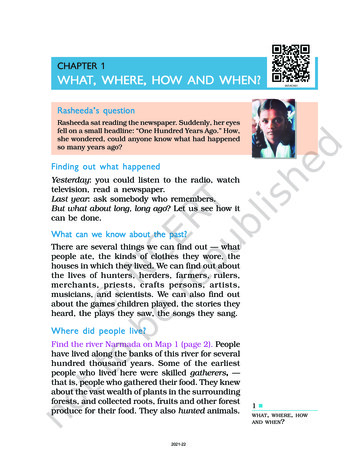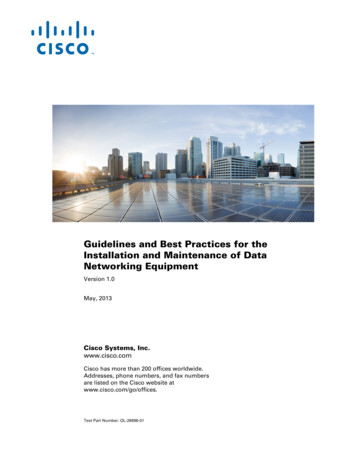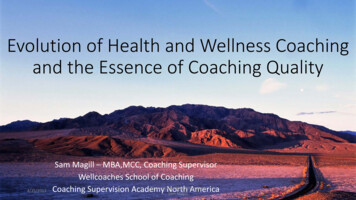
Transcription
CHAPTER 1WHAT, WHERE, HOW AND WHEN?WHATHOWRasheeda’s questionRasheeda sat reading the newspaper. Suddenly, her eyesfell on a small headline: “One Hundred Years Ago.” How,she wondered, could anyone know what had happenedso many years ago?Finding out what happenedYesterday: you could listen to the radio, watchtelevision, read a newspaper.Last year: ask somebody who remembers.But what about long, long ago? Let us see how itcan be done.What can ww about the past?wee knoknowThere are several things we can find out — whatpeople ate, the kinds of clothes they wore, thehouses in which they lived. We can find out aboutthe lives of hunters, herders, farmers, rulers,merchants, priests, crafts persons, artists,musicians, and scientists. We can also find outabout the games children played, the stories theyheard, the plays they saw, the songs they sang.Where did people live?Find the river Narmada on Map 1 (page 2). Peoplehave lived along the banks of this river for severalhundred thousand years. Some of the earliestpeople who lived here were skilled gatherers, —that is, people who gathered their food. They knewabout the vast wealth of plants in the surroundingforests, and collected roots, fruits and other forestproduce for their food. They also hunted animals.2021-221nWHAT, WHERE, HOWAND WHEN?
Now find the Sulaiman and Kirthar hills to thenorthwest. Some of the areas where women andmen first began to grow crops such as wheat andbarley about 8000 years ago are located here.People also began rearing animals like sheep, goat,and cattle, and lived in villages. Locate the Garohills to the north-east and the Vindhyas in centralIndia. These were some of the other areas whereMAP : 1Physical Map of the Subcontinentn2OUR PASTS–I2021-22
agriculture developed. The places where rice wasfirst grown are to the north of the Vindhyas.Trace the river Indus and its tributaries(tributaries are smaller rivers that flow into alarger river). About 4700 years ago, some of theearliest cities flourished on the banks of theserivers. Later, about 2500 years ago, citiesdeveloped on the banks of the Ganga and itstributaries, and along the sea coasts.Locate the Ganga and its tributary called theSon. In ancient times the area along these riversto the south of the Ganga was known as Magadhanow lying in the state of Bihar. Its rulers were verypowerful, and set up a large kingdom. Kingdomswere set up in other parts of the country as well.Throughout, people travelled from one part ofthe subcontinent to another. The hills and highmountains including the Himalayas, deserts, riversand seas made journeys dangerous at times, butnever impossible. So, men and women moved insearch of livelihood, as also to escape from naturaldisasters like floods or droughts. Sometimes menmarched in armies, conquering others’ lands.Besides, merchants travelled with caravans orships, carrying valuable goods from place to place.And religious teachers walked from village tovillage, town to town, stopping to offer instructionand advice on the way. Finally, some peopleperhaps travelled driven by a spirit of adventure,wanting to discover new and exciting places. Allthese led to the sharing of ideas between people.Why do people travel nowadays?Look at Map 1 once more. Hills, mountains andseas form the natural frontiers of the subcontinent.While it was difficult to cross these frontiers, thosewho wanted could and did scale the mountainsand cross the seas. People from across the frontiersalso came into the subcontinent and settled here.2021-22Facing Page: This is amap of South Asia(including the presentcountries of India,Pakistan, Bangladesh,Nepal, Bhutan and SriLanka) and theneighbouring countriesof Afghanistan, Iran,China and Myanmar.South Asia is oftencalled a subcontinentbecause although it issmaller than a continent,it is very large, and isseparated from the restof Asia by seas, hills andmountains.3nWHAT, WHERE, HOWAND WHEN?
These movements of people enriched our culturaltraditions. People have shared new ways of carvingstone, composing music, and even cooking foodover several hundreds of years.Names of the landTwo of the words we often use for our country areIndia and Bharat. The word India comes from theIndus, called Sindhu in Sanskrit. Find Iran andGreece in your atlas. The Iranians and the Greekswho came through the northwest about 2500 yearsago and were familiar with the Indus, called it theHindos or the Indos, and the land to the east ofthe river was called India. The name Bharata wasused for a group of people who lived in the northwest, and who are mentioned in the Rigveda, theearliest composition in Sanskrit (dated to about3500 years ago). Later it was used for the country.Finding out about the pastA page from a palm leafmanuscript.This manuscript waswritten about a thousandyears ago. The palmleaves were cut into pagesand tied together tomake books. To see abirch bark manuscript,turn to page 37.There are several ways of finding out about thepast. One is to search for and read books thatwere written long ago. These are calledmanuscripts, because they were written by hand(this comes from the Latin word ‘manu’, meaninghand). These were usually written on palm leaf,or on the specially prepared bark of a tree knownas the birch, which grows in the Himalayas.Over the years, many manuscripts were eatenaway by insects, some were destroyed, but manyn4OUR PASTS–I2021-22
have survived, often preserved in temples andmonasteries. These books dealt with all kinds ofsubjects: religious beliefs and practices, the livesof kings, medicine and science. Besides, therewere epics, poems, plays. Many of these werewritten in Sanskrit, others were in Prakrit(languages used by ordinary people) and Tamil.We can also study inscriptions. These arewritings on relatively hard surfaces such as stoneor metal. Sometimes, kings got their ordersinscribed so that people could see, read and obeythem. There are other kinds of inscriptions aswell, where men and women (including kings andqueens) recorded what they did. For example,kings often kept records of victories in battle.Can you think ofthe advantages ofwriting on a hardsurface? And whatcould have beenthe difficulties?Thereweremanyotherthings that weremade and used inthe past. Thosewho study theseobjects are calledarchaeologists.They study theremains of buildings made of stone and brick,paintings and sculpture. They also explore andexcavate (dig under the surface of the earth) tofind tools, weapons, pots, pans, ornaments andcoins. Some of these objects may be made of stone,others of bone, baked clay or metal. Objects thatare made of hard, imperishable substances usuallysurvive for a long time.2021-22An old inscription.This inscription datesto about 2250 yearsago, and was found inKandahar, present-dayAfghanistan. It wasinscribed on the ordersof a ruler namedAshoka. You will readabout him in Chapter8. When we writeanything, we use ascript. Scripts consistof letters or signs.When we read what iswritten, or speak, weuse a language. Thisinscription wasinscribed in twodifferent scripts andlanguages, Greek (top)and Aramaic (below),which were used in thisarea.5nWHAT, WHERE, HOWAND WHEN?
Left : A pot from an oldcity.Pots like these wereused about 4700 yearsago.Right : An old silver coin.Coins such as this onewere in use from about2500 years ago.In what ways is the coindifferent from the oneswe use today?Archaeologists also look for bones — of animals,birds, and fish — to find out what people ate in thepast. Plant remains survive far more rarely — ifseeds of grain or pieces of wood have been burnt,they survive in a charred form. Do you think clothis found frequently by archaeologists?Historians, that is, scholars who study the past,often use the word source to refer to the informationfound from manuscripts, inscriptions andarchaeology. Once sources are found, learningabout the past becomes an adventure, as wereconstruct it bit by bit. So historians andarchaeologists are like detectives, who use all thesesources like clues to find out about our pasts.One past or manmany?y?n6OUR PASTS–IDid you notice the title of this book, Our Pasts?We have used the word ‘pasts’ in plural to drawattention to the fact that the past was different fordifferent groups of people. For example, the livesof herders or farmers were different from those ofkings and queens, the lives of merchants weredifferent from those of crafts persons, and so on.Also, as is true even today, people followeddifferent practices and customs in different parts2021-22
of the country. For example, today most peopleliving in the Andaman Islands get their own foodby fishing, hunting, and collecting forest produce.By contrast, most people living in cities dependon others for supplies of food. Differences suchas these existed in the past as well.Besides, there is another kind of difference.We know a great deal about kings and the battlesthey fought because they kept records of theirvictories. Generally, ordinary people such ashunters, fishing folk, gatherers, farmers orherders did not keep records of what they did.While archaeology helps us to find out about theirlives, there is much that remains unknown.What do dates mean?If somebody asks you the date, you will probablymention the day, month and year, 2000 andsomething. These years are counted from thedate generally assigned to the birth of JesusChrist, the founder of Christianity. So, 2000means 2000 years after the birth of Christ. Alldates before the birth of Christ are countedbackwards and usually have the letters BC (BeforeChrist) added on. In this book, we will refer todates going back from the present, using 2000 asour starting point.7nWHAT, WHERE, HOWAND WHEN?2021-22
Letters with datesBC, we have seen stands for ‘Before Christ.’You will sometimes find AD before dates. Thisstands for two Latin words, ‘Anno Domini’, meaning‘in the year of the Lord’ (i.e. Christ). So 2012 canalso be written as AD 2012.Sometimes CE is used instead of AD and BCEinstead of BC. The letters CE stand for ‘CommonEra’ and BCE for ‘Before Common Era’. We usethese terms because the Christian Era is now usedin most countries of the world. In India we beganusing this form of dating from about two hundredyears ago.And sometimes, the letters BP meaning ‘BeforePresent’ are used.Find two dates mentioned on page 3. Which setof letters would you use for them?ElsewhereWe have seen that inscriptions are inscribed on hard surfaces. Many ofthese were inscribed several hundreds of years ago. All inscriptions containboth scripts and languages. Languages which were used, as well as scripts,have changed over time. So how do scholars understand what wasinscribed? This can be done through a process known as decipherment.PTKLOI OLPAn8OUROUR PASTSPASTS–I2021-22MI ISD (T)RA
One of the most famous stories of decipherment comes from Egypt, acountry in north Africa where there were kings and queens about 5000years ago.Rosetta is a town on the north coast of Egypt, and here an inscribedstone was found, which contained inscriptions in three different languagesand scripts (Greek, and two forms of Egyptian). Scholars who could readGreek figured out that the names of kings and queens were enclosed in alittle frame, called a cartouche. They then placed the Greek and the Egyptiansigns side by side, and identified the sounds for which the Egyptian lettersstood. As you can see, a lion stood for L, and a bird for A. Once they knewwhat the letters stood for, they could read other inscriptions as well.ImagineYou have to interview an archaeologist. Prepare a listof five questions that you would like to ask her/him.Let’s recall1.2.Match the following:Narmada ValleyThe first big kingdomMagadhaHunting and gatheringGaro hillsCities about 2500years agoIndus and its tributariesEarly agricultureGanga ValleyThe first citiesList one major difference between manuscripts ptionarchaeolog yhistoriansourcedeciphermentLet’s discuss3.Return to Rasheeda’s question. Can you think of someanswers to it?9nWHAT, WHERE, HOWAND WHEN?2021-22
SOME IMPORTANT4.Make a list of all the objects that archaeologists mayfind. Which of these could be made of stone?5.Why do you think ordinary men and women did notgenerally keep records of what they did?6.Describe at least two ways in which you think thelives of kings would have been different from thoseof farmers.DATESuthe beginning ofagriculture (8000years ago)uthe first cities on theIndus (4700 yearsago)ucities in the Gangavalley, a big kingdomin Magadha (2500years ago)uLet’s do7.Find the word crafts persons on page 1. List at leastfive different crafts that you know about today. Arethe crafts persons — (a) men (b) women (c) both menand women?8.What were the subjects on which books were writtenin the past? Which of these would you like to read?the present (about2000 AD/CE)n 10OUR PASTS–I2021-22
have lived along the banks of this river for several hundred thousand years. Some of the earliest people who lived here were skilled gatherers, — that is, people who gathered their food. They knew about the vast wealth of plants in the surrounding forests, and collected roots, fruits and











